

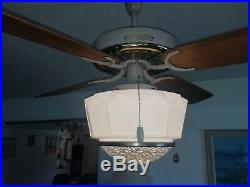
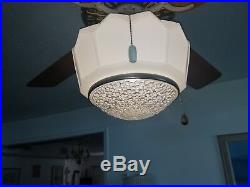

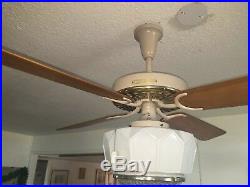

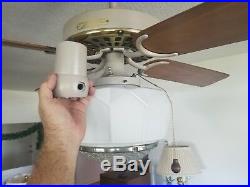
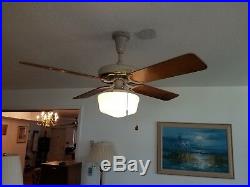
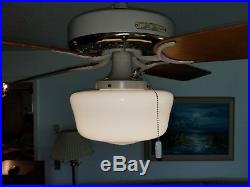


Brand New 60 yr old Hunter Ceiling Fan with Art Deco 6 Light Fitter 3 Speed (more photos below) Art Deco Globe shown not included. Chances are you will never see it again in this lifetime. We pulled this from the original box and touched up minor scuffs and scratches on the paint. If your home was built during the 1920’s, 1930’s, 1940’s, 1950’s or 1960’s this is the original style ceiling fan that would have been installed when new. While most appliances have improved since then, the Hunter Ceiling Fans have not. In fact, they are now made in China, they will not endure for decades as your home will. Why not put in the original style fan made in America that is Lifetime Guaranteed. If your home is in Tennessee (or even if you were simply born there) where this fan was made, you could take extra pride in that as well. Here is the youtube link. Some clues on Dating a Hunter Fan. If it says made in Tennessee it is after 1946. If it Says Robins & Myers it is after 1949. If it has no serial number it is after 1959. This fan came from a box marked R52. R52 fans were made between 1940 and the 1960’s. It also came with the inverted tulip shaped METAL switch housing which is prior to the 1970’s. It also features a NON-Capacitor shaded pole motor that uses a speed coil to change speeds. There is no capacitor to wear out. These are the same style Hunter motors made from 1906 to about 1986 that made Hunter Famous. Based on all the above we estimate the fan to be around 1960. ADVANTAGES OF SP SHADED-POLE VS THE PSC Permanent Split Capacitor. SP has far more torque than PSC. SP is more reliable than PSC, since capacitors blow out from time to time. We have SP fans still running after 100 years, whereas the PSC have only been out 35 years, so it is not as time tested as the SP motor. Hunter used SP fan motors for 60 years, from the 1906 Tuerk all the way thru the the 1960 where model numbers were used. In the 1970’s they changed from the SP to a 2 speed winding motor without speed coil or a capacitor. In the 1980’s they went to the PSC design. In 2000 the outsourced the fans to China. The Art Deco light globe could go back as far as the C17 (1917) over 100 years ago. The mount is called a 6″ fitter, but the width is 12″ and the depth is 9. It is all glass. It has a chrome band that allows the crystal bottom to come loose for easy bulb changing. I think they switched over to the 4 in the 1960’s so we are guessing at least 60 perhaps 90 years old. NO COST OPTIONS : We can switch the standard blade arms with Brass Adaptair blade arms that can reverse the air flow in either direction. We can also switch the canopy with a Brass one in either the long original style or the modern shorter style. Same goes with the mounting hardware, the original hook or the modern hook/bracket style. I will honor the original 5-year guarantee if this fan should ever fail under normal use. This fan uses the same oil bath lubrication system as all Hunters for the past 110 years. It takes just 1oz of standard 10 weight Hunter Oil and should be checked every 5 years. Under normal use, most people go 10 years without adding. The manual says it can also use 20 weight. It does not self destruct when it get low on oil, it will let you know with a slight fan noise. Track Page Views With. Auctiva’s FREE Counter. ABOUT HUNTER CEILING FANS. Hunter’s Famous History. Hunter fans are the finest fans available in the industry. The reason is to a great degree, the manner in which they are manufactured. They are not simply “assembled”. They are carefully crafted by dedicated workers, people who take special pride in the creation of these uncommon fans. These workers carry on the spirit and tradition started over 100 years ago. The same principles of quality that made the Original Hunter a legendary success have been carried over to the full line of Hunter fans. The same rigorous manufacturing, testing, engineering, and re-testing procedures are employed, whether your choice is an Original, the 1886 Limited Edition, Studio Series, or the Summer Breeze model. It costs more to make a Hunter fan because they are not built on high speed assembly lines where mistakes and flaws can go unnoticed. Instead, Hunters are created on quality-paced lines with the latest manufacturing and precision testing equipment. Dedicated assembly “teams” build complete Hunter fans from start to finish. They even “sign” their work with a special team color. Competition between teams is taken very seriously.. It is this uncommon pride that has contributed to the creation of the world’s finest fan… At the main Hunter plant in Memphis, Tennessee, demanding engineers and inspectors will not accept fans that whir, wobble or break down. Each fan is carefully tested for maximum performance, quiet operation, and overall quality of finishes. Motors and fan blades must conform to exacting standards that often involve extra hours of manufacturing time and quality control testing not associated with “look-alike” models. The Most Important Part Of The Fan – The Motor. A high quality fan begins with a high quality motor. Hunter’s larger, more powerful motors are built for years of smooth, dependable, maintenance free operation, with numerous advantages over the competition. They’re designed exclusively for each Hunter fan and are proven top performers. If a fan breaks down or isn’t working well – if it’s not moving much air – if it makes noise – if blades wobble – if it is just not efficient – the motor is usually the first place to look. A fan’s motor is integral to every part of its operation. It’s interesting then, that the motor is exactly where so many fan manufacturers cut corners. Many actually use off the shelf modified vacuum cleaner or dishwasher motors with cheap, noise-dampening rubber flywheels that need to be replaced periodically at a significant expense to the owner. Some also use non-precision ball bearings that make noise, no lubrication, and shorten a fan’s life. Hunter motors, on the other hand, are custom-designed for each fan. For example, the Hunter Original’s, one of-a-kind motor is one of the industry’s largest. Its cast iron housing makes it virtually indestructible, and effectively dissipates the motor heat that can ruin competitors’ fans. Hunter motors are engineered to perform, and built to last. The Original’s powerful motor is electrically reversible, with three operating speeds. It’s designed and built for smooth, balanced operation and maximum air movement. The Original motor uses precision-thrust ball bearings that assure quiet, dependable performance, with maintenance-free, permanent oil bath lubrication. Once installed, the Original never needs to be oiled (unless it’s moved). As of late 2002, Hunter original fans are no longer made in the USA and no longer have their famous cast iron motor, although the exterior motor housing is still cast. All non-Original motors have been carefully engineered specifically for use in Hunter Fans. The motor windings are designed to insure quiet efficiency even at the low speeds demanded in ceiling fans. A strong stable motor casing is provided to maintain the exacting tolerances and dimensions required for stable smooth operation. Special double shielded electric motor bearings are specified for long reliable and whisper quiet operation. Each motor armature is dynamically balanced to within 0.75 inches. This costly inspection process assures that the fan will operate smoothly, efficiently, and wobble-free. All motor windings are precision wound with highest quality copper wire. Motor windings, the electrical heart of the motor, are rigorously tested 4 different times during and after manufacturing. Hunter motors also have larger steel laminations with special epoxy coated insulation. This costlier type of insulation (inexpensive fans use paper) helps eliminate heat buildup and prevents motor burn out. The special epoxy covering is checked with a scientific probe for uneven coatings. Uneven coatings can contribute to electrical shorts and can shorten fan life. In addition to rigorous motor inspection, Hunter switches are tested to operate without failure for at least 20,000 cycles, a common failure on other fans. In addition, Hunter switches have an ingenious Break-Away switch chain. This Hunter invention eliminates having to replace your switch because the pull chain broke inside the switch housing. Pull too hard on a Hunter chain and it will break away at a pre-determined point outside the switch. Ready to be put together again in seconds. All Hunter fans feature 3-speed, electrically reversible motors. All motors manufactured at Hunter are inspected and tested in a sound proof room. This costly and time-consuming inspection procedure checks for proper RPM’S, fan speeds, correct electrical wattage and even loose or missing hardware. Each unit is hooked up and actually operated to check for noise and wobble. Remember, Hunters are quiet and wobble-free. A Hunter Fan For Every Room – Fan Selection. It’s easy to choose the right Hunter fan for your application. A ceiling fan that’s too big for a room can cause too much air movement, a fan that’s too small, not enough. Hunter makes fans for every application. For maximum efficiency and comfort, Hunter recommends. 52 fans for rooms up to 400 sq. 44″ or 42″ fans for rooms up 225 sq. 32 fans for rooms up to 64 sq. Installation Is A Breeze. All Hunter fans are simple to install, most without any extra wiring needed. Each is packed with easy-to-follow, step-by-step instructions that make the job a breeze. In general, if you can change a light fixture, you can install a ceiling fan. Many Hunter fans feature the versatile, three-position “Installer’s Choice” mounting system that lets homeowners mount their fans in the standard hanging configuration, flush to the ceiling for extra clearance, or at an angle on a vaulted ceiling. Vaulted ceiling kits are also available for mounting the Hunter Original at an angle. And for especially high ceilings, Hunter offers extension pipes in lengths from 12″ to 72″ and a variety of matching Hunter finishes. Hunter fans are as beautiful outside as they are tough inside. And they’re made to stay that way! Hunter’s unique brass finish is rust-resistant and tarnish-proof. It maintains its timeless beauty without polishing. All painted finishes are made to keep their good looks through years of use. And Hunter light kits offer finishes that match perfectly with the fans. Hunter’s Beautiful Brass Finish. The brass finish on most ceiling fans looks great at first, until it starts to tarnish or scratch. Not so with Hunter fans. The Hunter brass finish is deep and dimensional, unlike most inexpensive fans which have a cheap yellow tint. Hunter’s gleaming brass finish is the result of a series of buffing and grinding processes between multiple plating steps. This finish is then protected with a tough, baked-on epoxy coating. The result is a tarnish-proof, scratch and rust resistant finish that never needs polishing. It’s finished for life. Some Hunter fans are painted rather than plated. Hunter uses powder-coated paints that ensure proper coverage and a thick, glossy surface. Light Fixtures Made To Match. All Hunter light fixtures are finished with the same painstaking attention to beauty and durability as Hunter fans. Best of all, Hunter light fixtures are finished to precisely match the finish of Hunter fans, so metals never clash and the entire fixture is consistently beautiful. Rich, Real Wood Blades and Built with Care. Blades are obviously a fan’s most prominent feature. Hunter treats its blades like finely crafted wood furniture. Whether they’re beautifully finished with furniture grade hardwood veneers or painted with Hunter’s meticulous process, all Hunter blades are sealed to prevent warping and maintain a lifetime of good looks. Hunter also offers High Luster blades with gleaming polished surfaces of black, white or faux granite and a variety of rich wood grains. Each and every Hunter fan blade is hand-weighed, torque balanced to within seven grams and matched into sets of four. A balancing expert will also check and adjust level, pitch, angle and even place the blade irons in plastic bags to protect the finish. A scientifically specified level of moisture is maintained through the use of special drying ovens. Blades are cut to dimensional tolerances, sanded on both sides, and even sorted to eliminate visual pattern imperfections. Each blade is wrapped individually to protect it from damage another example of Hunter dedication to detail. Heavy die-cast metal blade irons, finished to match the motor housing, complete the quality Hunter blade assembly. Let’s face it: part of the beauty of a ceiling fan is the graceful circling of its blades. Hunter’s all wood blades are certainly beautiful. But, like every part of a Hunter fan, they’re also built for years of reliability. Each blade is properly sealed to keep out moisture and prevent warping. And they’re precision weighed to within one gram, to keep that circling motion graceful and wobble free. Die cast blade holders are also precision weighed, matched and aligned. Put them all together, and you have one smooth-running machine! The angle of a blade, or blade pitch, is a key factor in how much air a fan can move. Hunter’s motors are powerful enough so that fan blades may be pitched for optimum air movement. Hunter’s powerful motors are made to allow optimal blade pitch. Original blades are pitched at 15 degrees for maximum air movement. In fact, the 52 five-blade Original moves an astounding 9500 CFM (cubic feet of air) per minute more than any other ceiling fan designed for residential use. And many of Hunter’s high performance models move more than 8500 CFM and feature a 15 blade pitch. Hunter’s rigorous factory testing ensures excellence in design and performance. The proof is in Hunter’s warranties which are among the longest in the industry, and backed by the reputation of a 100-year-old company. If Hunter fans should ever need service, local authorized service centers can take care of most problems. Warranties that are unsurpassed provide an extra measure of assurance. With over 100 years in the fan business, Hunter’s, reputation for backing its products is unparalleled. It is only as worthy as the person or company offering it, and their ability to support it. Would you want your ceiling fan to be serviced by a lawn mower repair person? Some place in Hong Kong? Hunter fans have already withstood the critical test of time. They have made it easy, fast and convenient to get help whenever necessary. There are over 300 Service Centers throughout the continental U. All Hunter Service Center technicians are trained and continuously updated on the newest servicing techniques by Hunter factory instructors. In addition, a Hunter factory engineer in Memphis, Tennessee, also serves as a Technical Services Specialist. This person is always available to advise service center representatives on special problems. Hunter has developed a unique and personalized service to respond to Hunter customer calls for help with their fan problems. Hunter retains two full-time service experts in the Memphis factory service department. Five days a week, Central Time. Counseling regarding do-it-yourself repairs, installation and maintenance can help customers save time and inconvenience. Unlike other fan companies, Hunter is already planning for the next century, so you can believe that when you need Hunter. They’ll be here! These expert counselors in Hunter’s Memphis consumer service department can be reached at. The Hunter “Original” ceiling fan was a significant contributor to help pave the way for dramatic population growth in Americas warmer regions. Without its cooling breezes, who knows how quickly these regions would have been developed. An integral part of the history of this nation, Hunter fans began with a manufacturing concept so good that it has become a tradition. Refined, updated, enhanced a bit over the years, the Hunter Original is still the same basic masterpiece. The culmination of an idea conceived by the Hunters back in 1886 is now a full line of superb products by the name “Hunter”. Uncommon concern for quality has not changed over the years, either. Owning a Hunter means owning a classic, a tradition, a legend, not a “me too” copy. Expertly crafted thoroughly proven, exquisitely finished. Hunter fans have evolved to a level of perfection that is respected and admired by quality conscious people all over the world. Hunter has very little in common with the rest of today’s look-alike fans. Today, a whole new generation of Americans is discovering that ceiling fans are great not just for comfort, but for energy efficiency as well. Ceiling fans use less energy than air conditioners, and so help conserve our natural resources. They also don’t emit ozone-depleting chlorofluorocarbons. Don’t Settle For Imitations. Styles have changed over the years. Hunter has not only changed with them, but led the way with an impressive variety of fan styles for every need and decorating taste. One thing that hasn’t changed is Hunter’s commitment to quality workmanship and performance. Imitators come and go. Others may look the same. But the company that invented the ceiling fan is still making the highest quality, most dependable ceiling fans on the market today. The Memphis-based company produces more than 300 residential, commercial, and industrial ceiling fan models under such names as the 1886 Limited Edition, the Hunter Original, the Seville, and the Fantasy Flier. Accounting for nearly one percent of the room air conditioner market, Hunter has manufacturing operations in Memphis as well as in Mexico and the Far East. The Hunter Fan Company was founded in 1886 in Syracuse, New York, by James C. Hunter and his father, John Hunter, immigrants from Ireland. Originally known as the Hunter Fan and Ventilating Company, the fledgling business first engaged in the manufacture of water motors and meters. The founders expanded their operations to include the production of belt-driven fans, the power for which was first provided by water motors and later by the Tuerk Electric Motor, which they developed. The Hunter reputation for quality was established early in the company’s history: some of these earliest belt-driven fans are still in use today after more than a century. In 1889 the growing company moved its operations to Fulton, New York, where it would spend the next fifty years at a plant located at Front Street, extending from Huling Street to Tolbot Street. Twelve years later, upon the death of John Hunter, his six sons incorporated the company and focused their attention on expanding the production of ceiling fans. By the early 1920s, the company was widely known for its high-quality electric fans. Noted for their elaborate “Dragon” design, the electric fans were best suited for ceilings from ten feet and up and were advertised as ready for electric lights. By the early 1920s the Hunter name was widely known throughout the United States and the world. The fans were especially popular in India and China, and throughout the Far East, where thousands were exported each year. By the mid-1920s, desk oscillating fans had been added to the Hunter product line. In 1936, after purchasing the fan division of Century Electric Company, Hunter began manufacturing large pedestal air circulating fans and direct exhaust fans as well, which were used by many of the finest hotels and stores. Two years later, the company began producing attic fans as well. With the onset of World War II, the company suspended the manufacturing of ventilating equipment for consumer use and concentrated its efforts on aiding the war effort, producing belt fans for government use in Army hospitals and barracks, and portable ventilators and oscillators for the Navy. With the postwar boom in the U. Economy, Hunter expanded its operations to keep up with the growing need for commercial and industrial ventilating equipment. In 1946 the company moved its plant from Fulton to its present location in Memphis in order to take advantage of the rapid industrial expansion of the South. Three years later, Hunter was acquired by Robbins & Meyers, Inc. For the next 45 years, Hunter operated as a wholly owned subsidiary of Robbins & Meyers, producing a complete line of residential, commercial, and industrial fans. Although Hunter performed consistently well throughout the 1960s and 1970s, by the mid-1980s the company’s limited line of ventilating products, combined with the entrance of a number of new competitors into the market, brought on financial crisis. Clouspy, who took over as company chairman and chief executive officer. During the two years following the takeover, the management team guided the company through the financial crisis, developing a strategy of product diversification that made Hunter profitable once again. Solidifying its financial base by refinancing its remaining debt, Hunter was now in position to expand its operations through acquisition. A designer and importer of residential lighting products. In June 1987, the company went public under the name Hunter-Melnor, Inc. The company’s renewed success was attributed in part to the management style of Clouspy and his colleagues, who opted for a highly decentralized team of four presidents, each responsible for one division of the company. As Hunter was expanding its operations during this period, the company again underwent an organizational change. In 1988, just a year after it had gone public, the company was privatized through a leveraged buyout led by the investment firm Leach McMicking. The transition, however, did not impede the turnaround of the company. Boosted by the strong performance of the Melnor group and its line of garden chemical products, the Hunter group was able to take advantage of the expanding fan market, landing four new major customers: Payless Cashways, Kmart, Wal-Mart, and Target. Fan sales, once limited primarily to the South, had extended throughout the nation. While Miami, for instance, represented Hunter’s top sales city in 1984, Phoenix headed the list in 1987, followed by Philadelphia and Chicago. Driven by these forces, fan sales jumped from 1.2 million units in 1980 to 16 million in 1987, the company’s one-hundredth year of operation. As Hunter-Melnor, led by president and chief executive officer G. Competing in a market driven by such volatile factors as the weather, new home construction, and remodeling, Hunter and the rest of the industry were especially vulnerable to the recessionary economy of the late 1980s and early 1990s. Nevertheless, Hunter continued its pattern of growth by focusing on the remodellingsegment of the industry, where the demand for its upscale units represented the greatest potential for profit. While these strategies kept Hunter-Melnor at the forefront of the industry, the company’s profitable Hunter division was weighted down by debt affecting the entire company. To alleviate this problem and make each division bear the responsibility for its own debt, Hunter-Melnor was divided into two corporations in September 1991. Under the reorganization plan, Robert Beasely took over as the new president and chief executive officer of Hunter Fan. Kenroy International was placed under its control as a subsidiary. Less encumbered by debt, Hunter Fan was able to direct its attention and resources to advertising and product development. While continuing to emphasize the home fashion aspect of its ceiling fans, adding such models as the Fantasy Flier–a fan replica derived from a naval archival drawing of an F4U fighter plane&mdashø its product line, Hunter Fan launched the largest advertising campaign in the history of the industry. The company set the stage for its aggressive strategy in the summer of 1992 by reformatting its logo across all of its product lines, incorporating a new Hunter green color and introducing upscale packaging graphics. Starting in May 1993, the company began advertising a wide variety of its ceiling fans in 30-second prime time television spots and in such popular magazines as Newsweek and Sports Illustrated, in which two-page, four-color spreads appeared. The unprecedented advertisements emphasized both the multipurpose dimension of ceiling fans, showing their effectiveness in areas as diverse as the bathroom and the porch, and the economical advantages of the product, making the case that fans are a cost-effective alternative to air conditioning. In the summer of 1993, the company introduced more than a hundred new lighting fixtures, including models featuring weathered metal, colored glass, and textured finishes, strengthening its reputation as the leading supplier of upscale decorative fans. In October of that same year, the company added another potentially profitable market to its repertoire when the United States Food and Drug Administration approved its air purifiers as Class II medical devices. Accordingly, the company launched a national print ad campaign targeting consumers with ads in magazines such as Ladies Home Journal, Reader’s Digest, and Modern Maturity. Perhaps the company’s most innovative and publicized campaign began in February 1995, seven months into a major league baseball strike. Going against conventional wisdom, Hunter Fan unveiled a baseball-themed ceiling fan and introduced a nationwide “Why I Love Baseball” program, calling for baseball fans to write letters explaining why they cherish the national pastime. As an added incentive to the fans, the company awarded trips to the Baseball Hall of Fame in Cooperstown, New York, and ceiling fans to winners of the contest, which was judged by such well-known baseball fans as filmmaker Ken Burns, Sporting News editor John Rawlings, and the “Clown Prince of Baseball, ” Max Patkin. Instead of proving a liability, the strike actually succeeded in generating widespread interest in the contest and in the novelty item. With more than 225 U. Radio stations and a host of television stations and major publications covering the campaign, Hunter Fan was able to reap benefits from what may have first appeared to be a marketing disaster: in just the first few weeks of the campaign, the baseball fan became one of the company’s leading sellers. Behind the strength of its bold marketing strategy, Hunter Fan has entered its second century of operation well positioned for continued expansion. How far past this level the company will go depends largely on the state of the U. Construction market, the success of new competitors to the industry, and the height of the mercury on the thermometer. The item “New Vintage Brass 1960 Hunter Ceiling Fan w Antique Globe & Remote Control Opt” is in sale since Saturday, September 7, 2019. This item is in the category “Home & Garden\Lamps, Lighting & Ceiling Fans\Ceiling Fans”. The seller is “jj-do-it-products” and is located in Tampa, Florida. This item can be shipped to United States, Canada, United Kingdom, Denmark, Romania, Slovakia, Bulgaria, Czech republic, Finland, Hungary, Latvia, Lithuania, Malta, Estonia, Australia, Greece, Portugal, Cyprus, Slovenia, Japan, China, Sweden, South Korea, Taiwan, Thailand, Belgium, France, Hong Kong, Ireland, Netherlands, Poland, Spain, Italy, Germany, Austria, Bahamas, Israel, Mexico, New Zealand, Singapore, Switzerland, Norway, Saudi arabia, United arab emirates, Qatar, Kuwait, Bahrain, Croatia, Malaysia, Chile, Panama, Bolivia, Guadeloupe, Luxembourg, Uruguay, Bangladesh, Brunei darussalam, Egypt, French guiana, Guernsey, Gibraltar, Iceland, Jersey, Jordan, Cambodia, Liechtenstein, Monaco, Macao, Martinique, Nicaragua, Pakistan, Paraguay.
- Model: 22046
- Color: brass
- MPN: Does Not Apply
- Brand: Hunter
- Material: Brass
- Fan Width: 52″
- EAN: Does not apply
- Room: ANY


